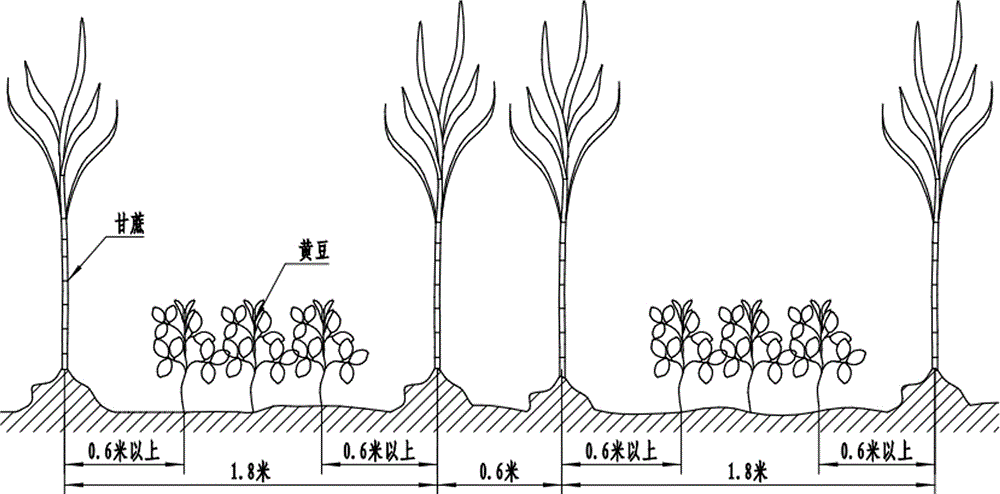Method for interplanting signal-bud sugarcane stalk seeds in single rows with soybeans in wide and narrow rows
A technology for sugarcane stems and wide and narrow rows, which is applied to the field of interplanting soybeans with single row and single bud sugarcane stems in wide and narrow rows, can solve the problems of unfavorable mechanized operation management, disorderly growth of sugarcane, large amount of sugarcane seeds, etc., and achieves the advantages of being beneficial to agricultural operations and reducing consumption. The effect of seed quantity and growth balance
- Summary
- Abstract
- Description
- Claims
- Application Information
AI Technical Summary
Problems solved by technology
Method used
Image
Examples
Embodiment 1
[0037] Use the following steps to complete the single-row single-bud sugarcane interplanting soybeans with wide and narrow stems:
[0038] (1) At the end of February and the beginning of March each year, cultivate the land according to conventional techniques, and ditch alternately with large row spacing and small row spacing. The trench depth is 30-45 cm, the width is 20-30 cm, the large row spacing is 1.8 meters, and the small row spacing is 0.6. Meter;
[0039] (2) Select sugarcane without diseases and insect pests, peel off the outer leaves of the sugarcane stalk, and cut the sugarcane stalk into segments with one bud eye per node, which must be cut with one knife to prevent the sugarcane from being chopped and cracked. Soak the fungicide for 3-5 minutes, then set aside;
[0040] (3) Place the prepared sugarcane seeds neatly in the ditch to form a single row of sugarcane buds, ensuring that there are 8-11 sugarcane buds per meter distance;
[0041] (4) Evenly apply farmyard compo...
Embodiment 2
[0053] Use the following steps to complete the single-row single-bud sugarcane interplanting soybeans with wide and narrow stems:
[0054] (1) At the end of February and the beginning of March each year, cultivate the land according to conventional techniques, and ditch alternately with large row spacing and small row spacing. The trench depth is 30-45 cm, the width is 20-30 cm, the large row spacing is 1.8 meters, and the small row spacing is 0.6. Meter;
[0055] (2) Select sugarcane without diseases and insect pests, peel off the outer leaves of the sugarcane stalk, and cut the sugarcane stalk into segments with one bud eye per node, which must be cut with one knife to prevent the sugarcane from being chopped and cracked. Soak the fungicide for 3-5 minutes, then set aside;
[0056] (3) Place the prepared sugarcane seeds neatly in the ditch to form a single row of sugarcane buds, ensuring that there are 8-11 sugarcane buds per meter distance;
[0057] (4) Evenly apply farmyard compo...
PUM
 Login to View More
Login to View More Abstract
Description
Claims
Application Information
 Login to View More
Login to View More - R&D
- Intellectual Property
- Life Sciences
- Materials
- Tech Scout
- Unparalleled Data Quality
- Higher Quality Content
- 60% Fewer Hallucinations
Browse by: Latest US Patents, China's latest patents, Technical Efficacy Thesaurus, Application Domain, Technology Topic, Popular Technical Reports.
© 2025 PatSnap. All rights reserved.Legal|Privacy policy|Modern Slavery Act Transparency Statement|Sitemap|About US| Contact US: help@patsnap.com

